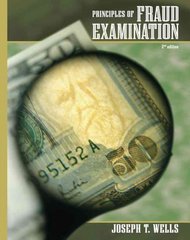Please look at #2 on this problem. The # of payments (4) is correct but the $960 and the $8,960 or incorrect.
Wiseman Video plans to make four annual deposits of $2,000 each to a special building fund. The fund's assets will be invested in mortgage instruments expected to pay interest at 12% on the fund's balance. ( FV of $1, PV of $1, FVA of $1, PVA of $1, FVAD of $1 and PVAD of $1) (Use appropriate factor(s) from the tables provided.) Using the appropriate annuity table, determine how much will be accumulated in the fund on December 31, 2016, under each of the following situations. 1. The first deposit is made on December 31, 2012, and interest is compounded quarterly Using the FV of $1 chart, calculate the fund balance: Deposit Date i= n= Deposit Fund Balance 12/31/2016 12/31/2012 12/31/2013 12/31/2014 12/31/2015 3% 3% 3% 3% 16 12 8 4 $2000 $2000 $2000 $2000 = 2000*1.60471 = 3209.42 = 2000*1.42576 = 2851.52 = 2000*1.26677 = 2533.54 = 2000*1.12551 = 2251.02 Total = $10845.50 As interest is calculated quarterly i = 12/4 = 3% n = 4* no of years The first deposit is for 4 years, so n =16 The second deposit is for 3 years, so n =12 The third deposit is for 3 years, so n =8 The fourth deposit is for 3 years, so n =4 The FV of 1$ deposit is taken from the table with corresponding n and i as per table above The fund balance is calculated as FV of 1$ * deposit. So, for first row Fund balance = 1.60471*2000 2. The first deposit is made on December 31, 2012, interest is compounded annually, and interest earned is withdrawn at the end of each year. Deposit Amount No. of Payments Interest left in fund Fund Balance 12/31/2016 $2,000 4 $960 $8960 As, the interest is withdrawn after every year, so only the principal is left in the account. In the final year, the interest is calculated on the total amount of 4*$2000 = $8000 Wiseman Video plans to make four annual deposits of $2,000 each to a special building fund. The fund's assets will be invested in mortgage instruments expected to pay interest at 12% on the fund's balance. (FV of $1, PV of $1, FVA of $1, PVA of $1, FVAD of $1 and PVAD of $1) (Use appropriate factor(s) from the tables provided.) Using the appropriate annuity table, determine how much will be accumulated in the fund on December 31, 2016, under each of the following situations. 1. The first deposit is made on December 31, 2013, and interest is compounded annually. Table or calculator function Payment n= i= Fund balance 12/31/2016 FVA $1 $2,000 4 12% $9,559 2. The first deposit is made on December 31, 2012, and interest is compounded annually . Table or calculator function n= i= Fund balance 12/31/2016 FVAD $1 4 12% $10,700 3. The first deposit is made on December 31, 2012, and interest is compounded quarterly. Using the FV of $1 chart, calculate the fund balance: Deposit Date I= N= Deposit Fund Balance 12/31/2016 12/31/2012 3% 16 $2,000 $3,209 12/31/2013 3% 12 $2,000 $2,852 12/31/2014 3% 8 $2,000 $2,534 12/31/2015 3% 4 $2,000 $2,251 $10,846 4. The first deposit is made on December 31, 2012, interest is compounded annually, and interest earned is withdrawn at the end of each year. Deposit Amount No. of Payments Interest left in Fund Fund Balance 12/31/2016 $2,000 4







